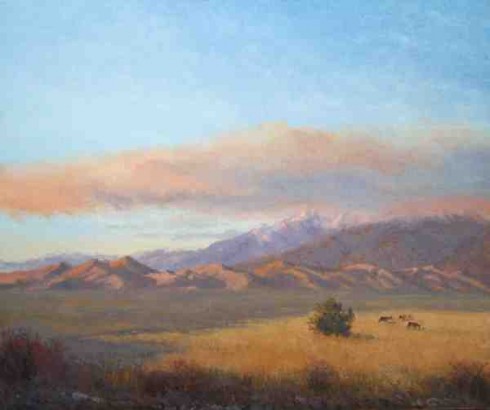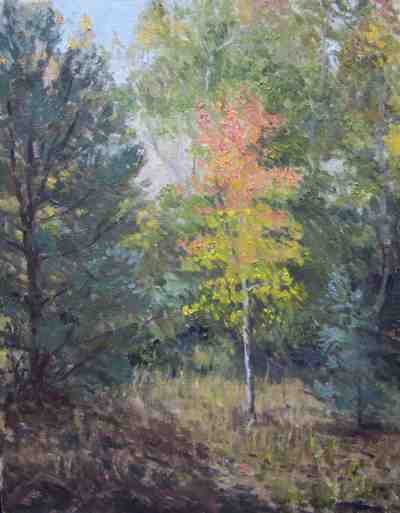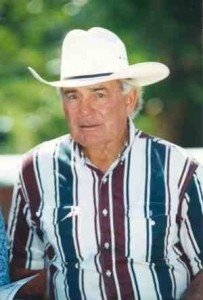Article by Marcia Darnell
Local Artists – November 2006 – Colorado Central Magazine
SOME LUCKY ACTIVISTS in the West are able to mix their jobs (what we do for money) and their work (what we do for ourselves). Landscape painter David Montgomery blends the hues of his life into a passion for land both in palette and preservation.
Montgomery has been in the San Luis Valley since 1965, when he was a freshman in high school and his father was transferred to Alamosa to run the J.C. Penney store. Montgomery’s studio today is just across Main Street from that store.

“I was always interested in art,” he says. He left the Valley to attend Colorado State University, where he earned a BFA. He deliberately — and foolishly, he admits — developed no fallback skills.
“I said, ‘I don’t need a second degree. I’m going to go right into art,'” he says, laughing.
He returned to Alamosa and took some studio space above the old Kavley’s store. He and another artist opened a gallery there in 1976.
“I sold about a painting a month,” he recalls, “which is about as well as I’ve done since.”
To keep body and soul together, he got a job shipping lettuce in the summers, which fits his lifestyle perfectly. “I kind of continued my college program of working in the summer and painting in the winter,” he laughs. “I’ve continued that for 30 years.”
He acknowledges that poverty and struggling sales are the consequence of art-making in rural Colorado. “To really make it in art, you need to go to an urban center or an art center, like Santa Fe,” he says, “but I make a conscious decision to live here.”
Montgomery’s environmental work is as much a part of him as his landscapes. He began his activist life in 1976, when he objected to a road planned into Wheeler Geologic Area. He led a movement to oppose it.
His desire to preserve special places made him many friends — and a few enemies.
(It also led to a huge fight with his father, a fight which cleared the dining room during a memorable family holiday. “We’ve agreed to disagree,” he says of their relationship today.)
His preservationist work also led to the founding of San Luis Valley Wilderness.
“I kind of became evangelical about it,” he says. “Every wilderness area we aimed to protect is now protected, including Goose Creek, the southern San Juans, and more.”
He is also a founding member of the San Luis Valley Ecosystem Council, working with San Luis Valley legend Chris Canaly.
“David has just been a wonderful person to work with,” says Canaly. “I appreciate the opportunity to get to know him as an artist as well as an activist.

“His reverence for the landscape and the sustenance he gets from seeing ecosystems intact, I think, he sees that as a source for his art. He interweaves that activism with the landscape to be able to create the vitality that exists there. They’re inextricably linked.”
Montgomery says his activism has been as time-consuming as his money-making ventures.
“I’m very proud of that legacy,”he says.
That legacy is visible in the Valley’s preserved space, which in turn feeds Montgomery’s art.
“Living in the Valley has nurtured and inspired my work. Looking at the Sangres every day — the light and the sculpture of them is amazing — and the Sand Dunes — they’re like a nude woman reclining against the solid backdrop of the mountains. And there’s the San Juans — they’re as beautiful as any mountains I’ve seen.
“I can get in my car with my paints and drive for two hours and I can be in alpine tundra, at the bottom of a gorge, in sandstone country, or at a waterfall. It’s incredibly diverse.”
Montgomery’s paintings celebrate the different landscapes he’s experienced. The works are of impressionistic style up close, and look like photographs from a few feet away.
“My hero, Claude Monet, was called ‘a 10-foot realist,'” he says. “I’m a 2-foot Monet.”
HIS SECOND-FLOOR STUDIO has large windows facing north. It’s filled with paintings and sketches. One wall holds, almost as an afterthought, a dry board with handwritten lists of which of his works are hanging in which businesses. It’s obviously a space devoted to creativity.
“I paint with a number-one brush, a very small brush,” he explains, “and the viewer completes the work.”
He has a mirror in the studio, and often checks out the painting in reverse image. “It also helps me ‘double’ the distance from which I view the work,” he explains.

His painting “Such a Fine Day” is the view from a hilltop overlooking farmland in Ireland. The perspective of the work and its realistic colors make it look like a snapshot.
“I’m using impressionist technique to create the illusion of reality,” he says.
Montgomery’s older works look completely different. His collection of “Hobbit Habitats” look both fantastic and primitive. He also did several of what he calls “stylized geological forms.”
He does sketches, what he calls “storyboards” before beginning to paint.
“When you invest 40 or 50 hours in painting, you want a good foundation,” he says.
Maintaining his foundation in life, Montgomery is part of a drawing group that meets weekly. “We get together and hire a model and drink coffee and talk. It’s my Elks Club — it feeds my social needs.”
His wife, Cynthia Cutts, is also an artist. Her pottery holds a place of honor in his studio. The couple has a daughter, Coral, who is a senior at Colorado College.
Montgomery has been featured in American Artist magazine, and has shown his work in New York, New Orleans, and Taos. Landscape lovers can see his stuff now at DavidMontgomeryPaintings.com or live in Alamosa at Treasure Alley, Inn of the Rio Grande, and the Cottonwood Inn.
Montgomery himself can be seen painting in his studio above Colorado Sports, shipping lettuce at the warehouse, or campaigning to save the land he loves. In other words, working to maintain a balanced, blended life.
Marcia Darnell lives and writes in Alamosa. She loves visiting artists’ studios and soaking up the creative energy.


